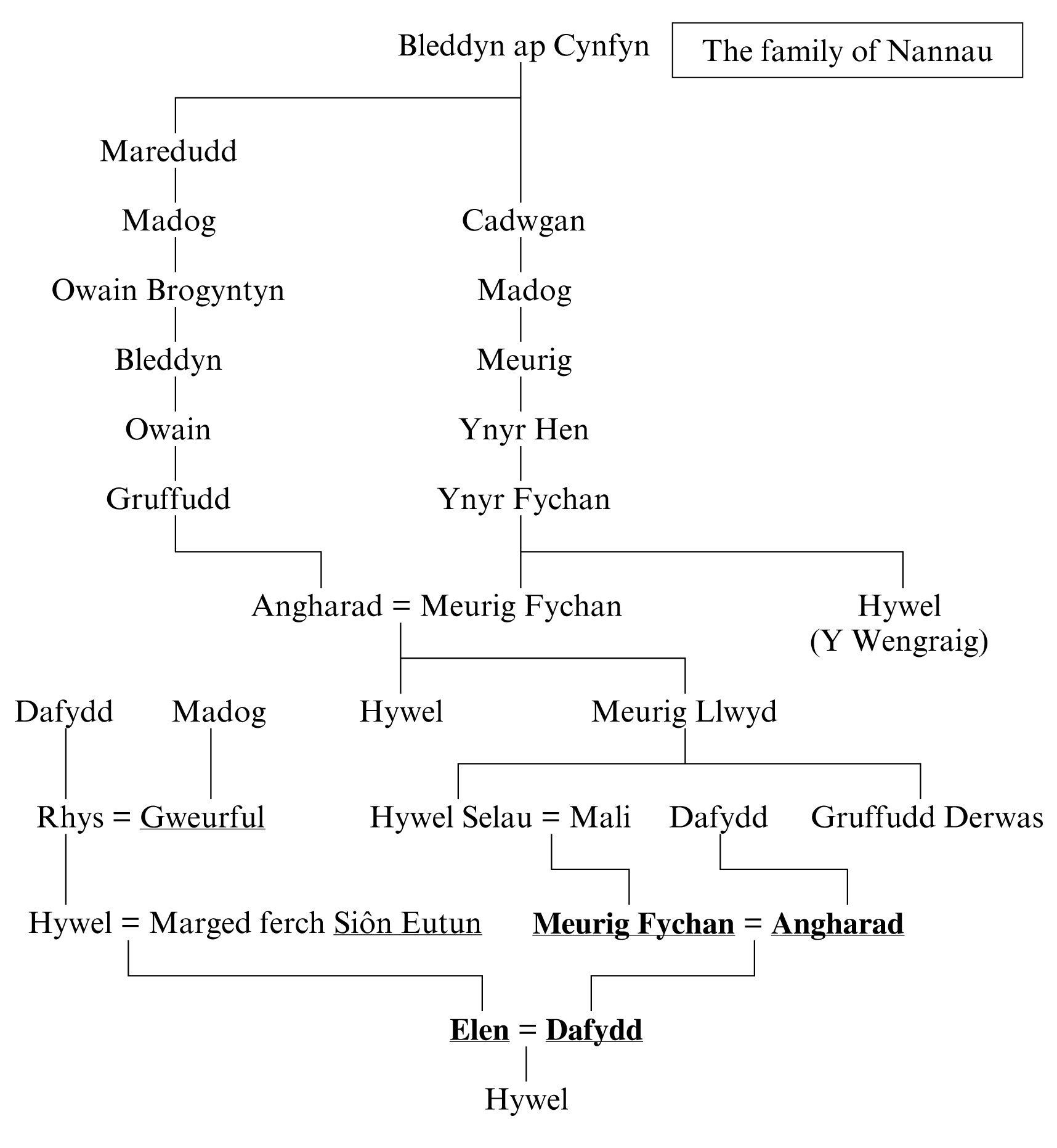Dafydd ap Meurig Fychan was the son of Meurig Fychan ap Hywel of Nannau and his wife, Angharad daughter of Dafydd. The poems by Guto are the only poems to Dafydd and his wife, Elen daughter of Hywel. He composed a praise poem to the whole family (poem 49) and a poem to thank both Dafydd and Elen for a horse (poem 51).
Lineage
The genealogical table below is based on WG1 ‘Bleddyn ap Cynfyn’ 51 A. The names of Guto’s patrons are underlined.
Dates
Dafydd ap Meurig Fychan inherited Nannau after the death of his father, Meurig Fychan ap Hywel. His name occurs in the Nannau manuscripts in 1480, but because of a gap in the documents between 1460 and 1480, we can assume that he inherited the estate at some point during this period. In 1471/2, we know that he was beadle of Tal-y-bont, a position that he held throughout Edward IV’s reign (Parry 1958: 94). However, there is no mention of him serving Henry VII, and according to Parry (ibid. 99), this could be significant: ‘Possibly Dafydd made a slight mistake and over-trimmed his sails, with the result that he held no office in his county under Henry Tudor.’ This belief derives from the conclusion that during the Wars of the Roses the Nannau family supported whichever side would be the most beneficial to them.
There are some references to Dafydd at the end of the fifteenth century, mostly involving lands in Merionethshire. He bought a tenement in Penllyn in 1480, he was involved in a dispute over his inheritance in 1487 and in 1490 he encroached on Crown lands in Llwyngwril (Parry 1958: 98; Thomas 2001: 220). This last case has survived, in which Dafydd presented a petition at the Great Sessions held at Caernarfon court before Sir William Stanley (Parry 1958: 99 and 103). Guto also suggests that he had great knowledge of the law, but there is no further evidence to support this. However, Dafydd’s will, proved in 1494, has survived, a rare occurrence in fifteenth-century Wales. He bequeathed money to many buildings, such as Cymer abbey (where he wished to be buried), Llanfachreth church and the church of Saint Mary at Dolgellau. Interestingly, he also bequeaths eight pence towards glazing the windows of the chapel of the Knights of St John at Gwanas, a building that was founded by the knights in the early Middle Ages but has now disappeared. His eldest daughter, Angharad, inherited most of the responsibility for the estate, which suggests that his son, Hywel, was still a minor when he died. His other five daughters also had a worthy share of the estate’s stock. Indeed, the will is extremely generous and therefore a valuable record of the wealth of the Nannau estate at the end of the fifteenth century (ibid. 105–6; Pryce 2001: 286; Owen and Smith 2001: 113).
Elen daughter of Hywel ap Rhys of Rug
The wife of Dafydd ap Meurig Fychan was Elen daughter of Hywel ap Rhys of Rug in Edeirnion. Her grandfather, Rhys ap Dafydd of Rug, was a descendant of Owain Brogyntyn, lord of Edeirnion in the twelfth century (WG1 ‘Bleddyn ap Cynfyn’ 20). His wife was Gweurful ferch Madog, yet on his death she remarried and moved to Abertanad, where she gave patronage to Guto. Guto’s elegy to Gweurful has survived (poem 88), and her son from her second marriage, Dafydd Llwyd, was also a patron. Her son from her first marriage with Rhys ap Dafydd, namely Hywel ap Rhys, inherited Rug, and he married Marged daughter of Siôn Eutun of Parc Eutun, another of Guto’s patrons (WG1 ‘Bleddyn ap Cynfyn’ 21; Carr 1961–4: 298). Very little is known about Elen’s dates and it is not known when she was married to Dafydd ap Meurig Fychan. Guto does not mention Dafydd’s and Elen’s children, but it is likely that their son, Hywel ap Dafydd, inherited Nannau following his father’s death in 1494. Tudur Aled composed a poem to Hywel when he inherited the estate (TA poem LVII), and Mathau Brwmffild composed an elegy for him when he died c.1540 (GMB poem 10).
Bibliography
Carr, A.D. (1961–4), ‘The Barons of Edeyrnion, 1282–1485’, JMHRS 4: 187–93, 289–301
Jones, E.D. (1953–6), ‘The Family of Nannau (Nanney) of Nannau’, JMHRS 2: 5–15
Owen, D.H. and Smith, J.B. (2001), ‘Government and Society 1283–1536’, J.B. Smith and Ll.B. Smith (eds.), History of Merioneth Volume II: The Middle Ages (Cardiff), 60–136
Parry, B.R. (1958), ‘The History of the Nannau Family (Meirionethshire) to 1623’ (M.A. Cymru [Bangor])
Pryce, H. (2001), ‘The Medieval Church’, J.B. Smith and Ll.B. Smith (eds.), History of Merioneth Volume II: The Middle Ages (Cardiff), 254–96
Smith, Ll.B. (2001), ‘Towns and Trade’, J.B. Smith and Ll.B. Smith (eds.), History of Merioneth Volume II: The Middle Ages (Cardiff), 225–53
Thomas, C. (2001), ‘Rural Society, Settlement, Economy and Landscapes’, J.B. Smith and Ll.B. Smith (eds.), History of Merioneth Volume II: The Middle Ages (Cardiff), 168–224






